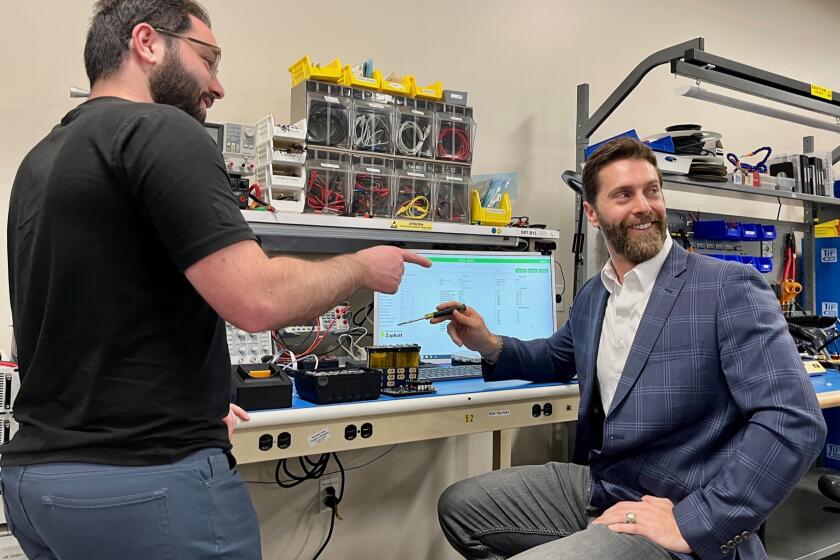Qualcomm CEO: ‘We have to pivot the company’

Restructuring will better position company in markets like the Internet of Things, wireless health
It has been a rough year for Qualcomm.
In July, the San Diego smartphone chip maker announced it would cut 15 percent of its global workforce and examine splitting into two separate companies.
The moves came after activist investor Jana Partners took a large stake in the company a few months earlier amid lackluster performance. Qualcomm’s share price has dropped 24 percent so far this calendar year – though part of that decline stems from the recent market sell-off.
For Chief Executive Steve Mollenkopf, it means the pressure is on. He took over as part of a management change about 15 months ago. First, he dealt with an anti-monopoly probe by the Chinese government that resulted in a $975 million fine but kept Qualcomm’s technology licensing business model intact.
Now he’s restructuring the company with an activist investor looking over his shoulder.
Qualcomm is San Diego’s largest technology firm, with $26.5 billion in revenue last year. It employs 31,300 globally and around 15,000 in San Diego. It hasn’t handed out pink slips yet, but they are expected to come shortly.
The company says the restructuring will better position it in emerging growth markets such as connected cars, the Internet of Things, wireless health, small cells and the data center, among others.
Mollenkopf spoke with the San Diego Union-Tribune this week about the rationale behind the company’s moves and his view of the future. Here are some excerpts.
Q: What’s the status of Qualcomm today?
A: The company is exactly 30 years old, which is amazing given all the things we have done. Now we are in a position where we have to pivot the company.
Those of you who know our history know we have had to do this a number of times. We are working on where do we grow outside of the phone.
The phone continues to be a great business. It is going to continue to grow. We are in the enviable position to be able to use the phone market, which is very diverse in terms of technology, to allow us to grow into new areas
So a lot of what we are doing this year is repositioning the company’s resources so we can continue to deliver on the phone opportunity but more importantly deliver on these new opportunities.
Q: To pivot the company, you have to know where to go. So where do you go beyond the phone?
A: In general, what characterizes these opportunities are a bunch of industries that are trying to figure out how do I leverage what’s happening on the phone.
The car is great example of that. The user experience of the car – the new components – are related to the fact that the car is connected to the Internet.
Every major car company is trying to figure out how do I deploy the Internet into the car? How do I get cars to talk to each other? How do I get more safety? How do I get the ownership experience to change dramatically as a result?
That’s just one. Health care is another, the Internet of Things. So there are number of different markets that we think will leverage mobile technology. And our job is to pivot the company to take advantage of that over the next five years.
Q: How big are these businesses?
A: If you look at each individual opportunity, it’s not that big actually. But if you look at them in aggregate, we did some projections. If you look at our chip business and take the products we already have, it’s a $10 billion market. And if you look at it over the next five years, it’s a $20 billion market.
That’s pretty significant for us. Not only are these markets growing, but we are not starting from scratch. We are already delivering over $1.5 billion into these markets.
Q: You are getting ready to lay off thousands of people. Who is going to do this work?
A: If you look at the company, we have grown tremendously, particularly over the last five years, in terms of the business as well as the number of people we have.
We probably have too many people in the core handset business, and we need to redeploy assets to some of these other businesses. Sometimes those assets need a different skill set. Some people in San Diego unfortunately will be impacted by that.
Q: How many people in San Diego?
A: We haven’t announced, but it will be clear here soon. Obviously Qualcomm is very committed to San Diego, and we are going to help the people get redeployed to the degree that we can. We have always been supportive in these types of situations. We also think people who come out of Qualcomm are pretty well trained. So we are hoping they will be good participants in some of these companies that we are going to be partnering with.
Q: You are using the term redeploy. You are talking about layoffs, aren’t you?
A: I think we are doing both. If you look at the size of the business, it needs to be a different size. We are just at a point where the industry is changing, and successful companies need to get ahead of that and redeploy for the next wave of growth.
Now to be clear, we are still going to be a very significant technology company. We are going to spend over $4 billion a year in research and development even after we do the restructuring.
Q: A 15 percent head count reduction is a significant layoff. What mistakes were made and why won’t they happen again?
A: I think our track record as a company, our track record in terms of doing new technology and our position going into these new businesses, is one of strength. We just need to have a different size business – smaller in some areas and bigger in other areas.
We are not unlike other technology companies that have to make these changes. It is part of being a 30-year-old company that has been successful. You have to make these pivots to be successful again.
Q: Can you talk about what’s happening in the core smartphone business?
A: If you look back to 2008, people didn’t have smartphones. Now everyone essentially has a smartphone. We had tremendous end market growth – 30 percent a year. Now the end market growth worldwide is not at that same rate.
It’s still significant. Remember, there are going to be 8 billion new smartphones (sold) over the next five years. So it is still going to be a strong business going forward, but we need to make sure it is structured to be profitable and successful in an environment where it is not growing at 30 percent a year anymore.
Q: When you come out of this pivot, do you want to come out as one company, two companies?
A: What we announced is we are taking a look at the corporate structure. We have done it numerous times in our past. When we are running the business, we are looking at things that can either help us in a negotiation or drive shareholder value.
We are working through it. We are going to make some decisions and an announcement before the end of the year.
That being said, we are very focused on what I would call the fundamentals of driving technology into the industry. Are we better off doing that as one company, two companies? Those are the type of issues that the board and management team deal with all the time, and we are doing it again this time.
Q: If Congress ever gets around to serious consideration of immigration reform, what is it that you want?
A: For us, even in a situation where you are restructuring a company, you want to make sure that the people that we train – because the U.S. university system is incredible – we want to make sure that we can keep those people working in the industry.
In some cases it makes it difficult to do that. That is the real fundamental problem that people are trying to address. You have these very smart people who are working on science and technology and will be the next innovators. How do you keep them working on your team – your country team?
Q: So they go to UC San Diego but can’t get a job at Qualcomm?
A: You do find that in certain cases. As a company, whatever the business outlook is, you want to make sure you have new skill sets coming into the company. That is difficult sometimes (under current immigration policy.)
Get U-T Business in your inbox on Mondays
Get ready for your week with the week’s top business stories from San Diego and California, in your inbox Monday mornings.
You may occasionally receive promotional content from the San Diego Union-Tribune.










